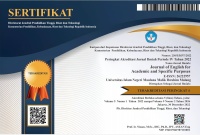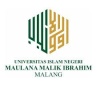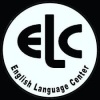A Content Analysis of English Teaching Module Entitled “Practical English”
Abstract
Full Text:
PDFReferences
Apriyani, D. (2016). Content Analysis on English Module “Bahasa Inggris”. Journal of English Language and Education .12.(1).
As Sabiq. A.H and Muflihah. (2021). Content Analysis of an EAP Coursebook in an Islamic University. Jetal: Journal of English Teaching and Applied Linguistics. 3(1).
Awasthi, J.R. (2006). Textbook and Its Evaluation. Journal of Nelta Vol. 11 No.. 1-2. http://www.nelta.org.np.
Barzegar. K. (2013). Development, validation, and justification of a comprehensive textbook evaluation model. Journal of Educational Research, Reviews and Essays 1, (1), 1-12.
Buck, G. (2001). Assessing Listening. Cambridge: Cambridge University Press.
Caleffi, P. (2016). ELF in the speaking and listening activities of recently published English-language coursebooks. Intercultural Communication: New Perspectives from ELF, 59-78. Rome: TrE-Pres.
Chaney, A.L., and T.L. Burk. (1998). Teaching Oral Communication in Grades K-8. Boston: Allyn&Bacon.
Chivers, B. & Shoolbred, M. (2007). A Students Guide to Presentation: Making Your Presentation Count. London, England: SAGE Publication Inc.
Cunningsworth, A. (1995). Choosing your Coursebook. Oxford: Macmillan Heinemann.
Dilla, R.G.S., Damayanti, I. and Hati, G.M. (2017). The Content Analysis of Bahasa Inggris Textbook for Senior High School Grade X Published by Kemendikbud 2014. Journal of English Education and Teaching (JEET) 1(1).
Dudley-Evans, T. and M. J. St. John. (1998). Developments in English for Specific Purposes: A Multi-disciplinary Approach. Cambridge: Cambridge University Press.
Ellis, R. (1997). The empirical evaluation of language teaching materials. ELT Journal, 51(1), 36–42.
Fraenkel, J. R., & Wallen, N. E. (2009). How to Design and Evaluate Research in Education. McGraw-Hill.
Goh, C. (1999). Teaching Listening in the Language Classroom. Singapore: SEAMEO Regional Language Centre.
Gol, A.K & Baghaeeyan, J. (2015). Critical Analysis and Teachers’ Perspectives on Prospect One (Iranian Junior High School English Book). International Journal of Language and Applied Linguistics; 1(4): 14-25.
Guariento, W., & Morley, J. (2001). Text and task authenticity in the EFL classroom. ELT
Guichon, N., & McLornan, S. (2008). The effects of multimodality on L2 learners: Implications for CALL resource design. System, 36(1), 85-93.
https://ejournal.unkhair.ac.id/index.php/edu/article/download/50/142
Humes, J., (2021) Basic Language Skills – Listening, Speaking, Reading & Writing. Retrieved September 26, 2022, from https://harappa.education/harappa-diaries/language-skills/#:~:text=Language%20skills%20are%20communication%20skills,crucial%20in%20a%20professional%20setting
Hyland, K. (2003). Second Language Writing. New York: Cambridge University Press.
Itakura, H & Tsui, A.B.M., (2011). Evaluation in academic discourse: Managing criticism in Japanese and English book reviews. Journal of Pragmatics. 43 (5), 1366-1379. https://doi.org/10.1016/j.pragma.2010.10.023
Kelly, C. & Kelly, L. & Offner, M. & Vorland, B. (2002).Effective ways to use authentic materials with ESL/EFL students. The internet TESL journal. 8(11). Retrieved: http://iteslj.org/Techniques/Kelly-Authentic.html
Krippendorff, K. (2004). Content Analysis: An Introduction to its Methodology (3rd Ed). Beverly Hills, CA: Sage.
Larsen- Freeman, D. (1986). Techniques & Principles in Language Teaching. Oxford: Oxford University Press.
McGrath, I. (2016). Materials Evaluation and Design for Language Teaching. Edinburgh University Press.
Meloni, C. & Thompson, S. (1980). Oral Report in The Intermediate ESL Classroom. TESOL Quarterly.
Mohamed, M. (2013). Developing an English Language Textbook Evaluative Checklist. IOSR Journal of Research & Method in Education (IOSRJRME), 201(3), 55–70.
Munawarah. (2021). A Content Analysis of the Language Skills Activities on the English Textbook for Tenth Grade of Secondary Schools. Published thesis. https://digilibadmin.unismuh.ac.id/upload/20070-Full_Text.pdf
Munro, M. J., & Derwing, T. M. (1999). Foreign Accent, Comprehensibility and Intelligibility in the Speech of Second Language Learners. Language Learning, 49(1), 285-310. Retrieved from http://dx.doi.org/10.1111/0023-8333.49.s1.8
Nation, I. S. P., & Newton, J. (2009). Teaching ESL / EFL listening and speaking. New York: Routledge.
Newton, J. & Nguyen, C. (2018). Integrating listening and speaking. In The TESOL encyclopedia of English language teaching (eds J. I. Liontas, T. International Association and M. DelliCarpini). Retrieved from doi:10.1002/ 9781118784235.eelt0602
Paltridge, B. (2001). Genre and the language learning classroom. Michigan: University of Michigan.
Rajaei, Z. (2015). The role of pre-listening activities on EFL learners’ listening comprehension. International Journal of Foreign Language Teaching and Research, 3(10), 35-43.
Richards, J.C. (2001). Curriculum Development in Language Teaching. Cambridge: Cambridge University Press.
Rutherford, W. (1980). Aspects of pedagogical grammar. Applied Linguistics, 1(1), 60–73.
Sarkhel, J. (2017). Indexing languages. Retrieved from http://egyankosh .ac. in/handle /123456789/35770
Shrum, J. L. & Glisan, E. W. (2000). Teacher’s handbook: contextualized language instruction. Boston: Heinle & Heinle.
Tarigan, H. G. (1986). Telaah Buku Teks Bahasa Indonesia. Bandung: Angkasa.
Tomlinson, B. (2008). English language learning materials: A critical review. London: Continuum.
Tomlinson, B. (2011). Materials Development in Language Teaching. Cambridge: Cambridge University Press.
Usman, A. H. (2015). Teaching vocabulary through Grammar-Translation method. Edukasi-Jurnal Pendidikan, 13 (2).
Westney, P. (1994). Rules and pedagogical grammar. In T. Odlin (Ed.), Perspectives on pedagogical grammar (pp. 72–96). Cambridge: Cambridge University Press.
Wilson, J. J. (2008). How to teach listening. Essex: Pearson Education Limited.
Zohrabi, M. & Sabouri, H. (2015). The Impact of Pre-Listening Activities on Iranian EFL Learner’s Listening Comprehension of Authentic English Movies. International Journal on Studies in English Language and Literature, 3(2), 42-56.
DOI: https://doi.org/10.18860/jeasp.v5i2.18995
Refbacks
- There are currently no refbacks.

This work is licensed under a Creative Commons Attribution-ShareAlike 4.0 International License.






Editorial Office:
Pusat Pengembangan Bahasa
Program Khusus Pengembangan Bahasa Inggris (PKPBI)
Universitas Islam Negeri Maulana Malik Ibrahim Malang
Gedung C lantai 1
Jl. Gajayana No 50 Kota Malang, Jawa Timur, Indonesia
Kode Pos 65144, Telp/Fax : (0341) 570872
Email: jeasp@uin-malang.ac.id
JEASP : Journal of English for Academic and Specific Purposes is licensed under a Creative Commons Attribution-ShareAlike 4.0 International












